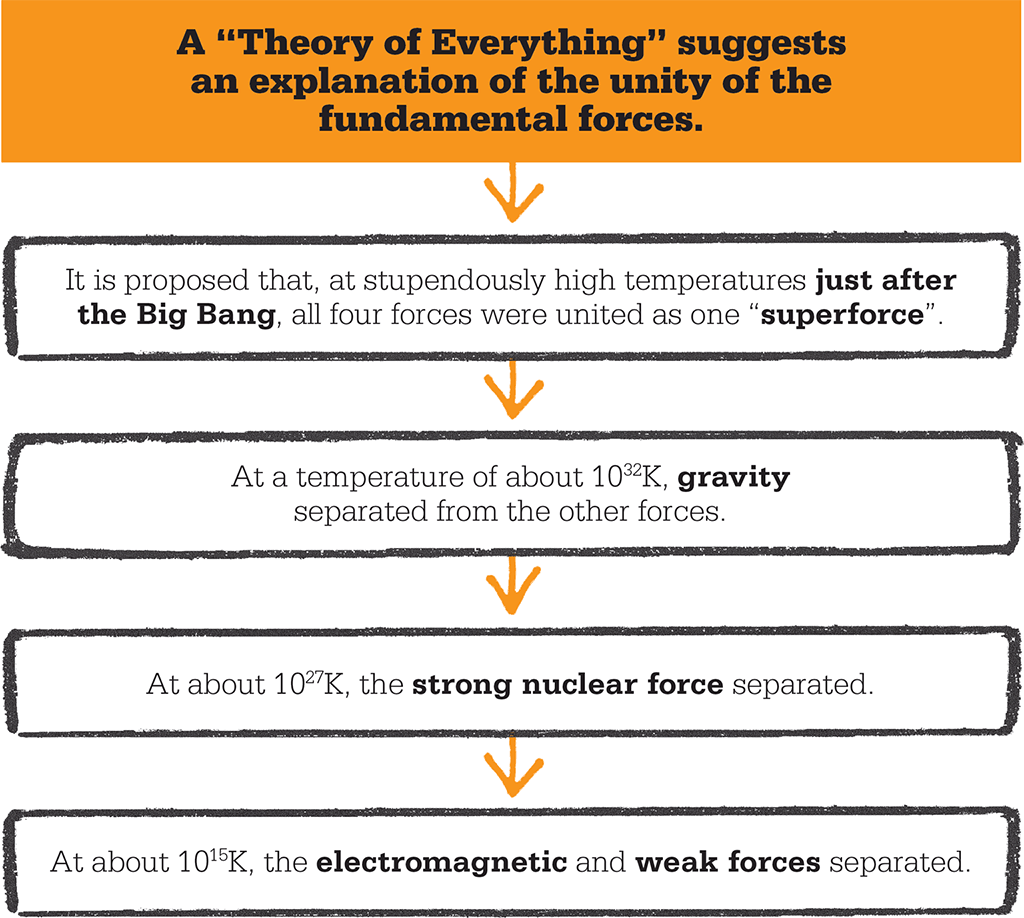
IN CONTEXT
Physics
1820 Hans Christian Ørsted discovers that magnetism and electricity are aspects of the same phenomenon.
1864 James Clerk Maxwell describes electromagnetic waves in a set of equations.
1933 Enrico Fermi’s theory of beta decay describes the weak force.
1954 The Yang–Mills theory lays the mathematical groundwork for unifying the four fundamental forces.
1974 A fourth kind of quark, the “charm” quark, is discovered, revealing a new underlying structure to matter.
1983 The force-carrying W and Z bosons are discovered in CERN’s Super Proton Synchrotron in Switzerland.
The idea of forces of nature, or fundamental forces, goes back at least to the ancient Greeks. Physicists currently recognize four fundamental forces – gravity, electromagnetism, and the two nuclear forces, weak and strong interactions, which hold together the subatomic particles inside the nucleus of an atom. We now know that the weak force and the electromagnetic force are different manifestations of a single “electroweak” force. Discovering this was an important step on the way to finding a “Theory of Everything” that would explain the relationship between all four forces.
The weak force
The weak force was first invoked to explain beta decay, a type of nuclear radiation in which a neutron turns into a proton inside the nucleus, emitting electrons or positrons in the process. In 1961, a graduate student at Harvard, Sheldon Glashow, was given the ambitious brief to unify the theories of weak and electromagnetic interactions. Glashow fell short of this, but did describe the force-carrying particles that mediate interaction via the weak force.

Messenger particles
In the quantum mechanical description of fields, a force is “felt” by the exchange of a gauge boson, such as the photon, which carries electromagnetic interaction. A boson is emitted by one particle and absorbed by a second. Normally, neither particle is fundamentally changed by this interaction – an electron is still an electron after absorbing or emitting a photon. The weak force breaks this symmetry, changing quarks (the particles that protons and neutrons are made from) from one kind to another. So what kind of boson might be involved? Glashow guessed that the bosons associated with the weak force had to be relatively massive because the force operates over miniscule ranges and heavy particles do not travel far. He proposed two charged bosons, W+ and W–, and a third neutral Z boson. The W and Z force-carriers were detected by CERN’s particle accelerator in 1983.

Decay of particles via the weak force drives the Sun’s proton–proton fusion reaction, turning hydrogen into helium. Without it, the Sun wouldn’t shine.
Unification
In the 1960s, two physicists, American Steven Weinberg and Pakistani Abdus Salam, working independently, incorporated the Higgs field into Glashow’s theory. The resultant Weinberg–Salam model, or unified electroweak theory, brought weak interaction and electromagnetic force together as a single force.
This was an astounding result, as the weak and electromagnetic forces operate in entirely different spheres. The electromagnetic force extends to the very edge of the visible universe (the force is carried by massless photons of light), while the weak force barely reaches across an atomic nucleus and is some 10 million times weaker. Their unification opens up the tantalizing possibility that, under certain high-energy conditions such as those just after the Big Bang, all four fundamental forces may coalesce into one “superforce”. The search continues for evidence of such a Theory of Everything.
SHELDON GLASHOW

Sheldon Lee Glashow was born in New York in 1932, the son of Russian Jewish immigrants. He attended high school with his friend Steven Weinberg and on graduating in 1950, they both studied physics at Cornell University. Glashow took his PhD from Harvard, where he came up with a description of the W and Z bosons. After Harvard, he went to the University of California at Berkeley in 1961, and later returned to join the faculty at Harvard as a professor of physics in 1967.
In the 1960s, Glashow extended Murray Gell-Mann’s quark model, adding a property known as “charm” and predicting a fourth quark, which was discovered in 1974. In recent years, he has been heavily critical of string theory, disputing its place in physics due to its lack of testable predictions, and describing it as a “tumour”.
Key works
1961 Partial Symmetries of Weak Interactions
1988 Interactions: A Journey Through the Mind of a Particle Physicist
1991 The Charm of Physics
See also: Marie Curie • Ernest Rutherford • Peter Higgs • Murray Gell-Mann